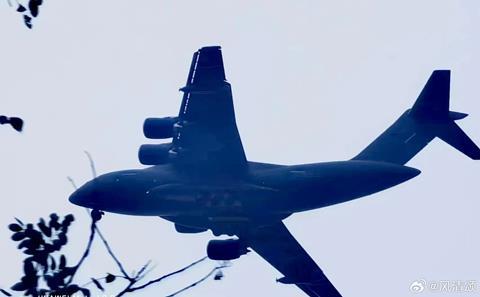A version of China’s Xian Y-20U tanker with new high bypass engines has been spotted, as Beijing works to improve its air-to-air refuelling capabilities.
Images posted on Chinese social media site Weibo show the Y-20U equipped with what appear to be four Shenyang WS-20 engines, in place of the Soloviev D-30KP2s that power baseline Y-20s and Y-20Us.

The re-engined version of the tanker is alternatively designated YY-20B. The images are notable in that the jet bears People’s Liberation Army Air Force (PLAAF) markings. It is not clear, however, if the aircraft is in active service.
The aircraft has a pod under each wing outboard of the engines for hose-and-drogue refuelling. It lacks, however, the centerline refuelling pod seen on previous Y-20Us.
Given the WS-20’s improved bypass ratio, Y-20Us with the updated powerplant should have superior endurance and refuelling capacity.
The WS-20 is likely to become the standard powerplant for the Y-20 transport and its various derivatives, including the tanker and a possible airborne early warning and control version.
In its annual report to the US Congress about Chinese military developments, the Pentagon said that that the Y-20 fleet will enhance the PLAAF’s ability to operate beyond the first island chain – the series of island nations that encloses the seas adjacent to China.
Separately, images have also emerged suggesting that China’s newest aircraft carrier, CNS Fujian, has started conducting tests for its electromagnetic aircraft launch system (EMALS).
The images, the progeny of which is uncertain, show a scarlet-painted sled on the ship, like those used to test the catapults of US carriers.
Launched in 2022, Fujian is China’s third aircraft carrier. Work is underway to complete the vessel in Shanghai’s Jiangnam shipyard.
EMALS will allow the 80,000t Fujian to launch aircraft with heavier payloads than China’s current pair of in-service carriers, CNS Liaoning and Shandong, both of which use a ski-jump ramp to launch aircraft.





























